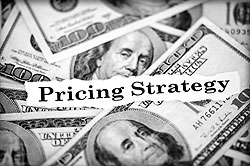Pricing Strategies: How to Price Your Product or Service–To Avoid Killing Your Business
 “How do I price my product?” another entrepreneur recently asked to an email list I’m on. “I’ve looked at our competitors, and I know how much it costs to produce what we offer. I think I know what my audience will pay. So–looking at all of that–what’s the best pricing strategy?“
“How do I price my product?” another entrepreneur recently asked to an email list I’m on. “I’ve looked at our competitors, and I know how much it costs to produce what we offer. I think I know what my audience will pay. So–looking at all of that–what’s the best pricing strategy?“
Pricing questions are never the easiest questions to answer, but having worked with a lot of business owners helping them grow their businesses, I have some suggestions.
Make Sure Your Market Pays
There are some markets out there that are famous for not paying. It’s not you–they just don’t have the money. Students are the best example. They’re cash-strapped and they usually have a fair amount of spare time on top of that. They’re a terrible market to try to sell to (no offense to any students reading this–I ate my fair share of fast food and used coupons for everything when I was a student, too!)
Hobbyists are another example of a quintessential “terrible market”. The whole point of a hobby is that you spend time doing something you enjoy. There are a few successful niches here (selling supplies for a hobby market is reasonably lucrative) but since it’s not integral to that person’s day-to-day life, hobby spending is going to be low on their priority list.
My personal favorite “terrible market” is one I’m definitely a part of: Geeks and nerds. We (and believe me, I include myself in this category) are so stingy that we’ll spend 8 hours building a computer and setting it up from scratch to save a few hundred bucks. Yep, been there, done that. If your target market is geeks, and you think you’re going to build a hugely successful product for that niche, just know that “Why should I pay you when I can build it myself?” is going to be a common objection. You’re going to have to quickly explain why your product is better than something they could cobble together themselves. Even then, you’re going to have a frustrating time, as many of them will choose to build it themselves anyway.
That advice applies equally to hardware and software, by the way. Geeks love to spend time building software. Similar to the hobbyist market, the most successful companies that cater to the geek market are going to be ones that geeks can build things on top of, like Heroku (a hosting service built for geeks, by geeks) or Github (a website that easily lets you share your software’s source code with others.) These services are so successful because they make it easier for geeks to share their creations with the world. You can also see success in the geek market with products that make it easier to build a project (think geek equivalents of hobby kits, both physical and software-related.)
The good news is that it’s likely that if you’re a part of these markets, and were thinking about selling to one of these markets, there’s probably a more lucrative market close by. There are some folks who want do-it-yourself instructions, but often there are far more people who would just like it done for them. There are lots of people who will buy $30 plans to create a bookshelf themselves, but on the other end of the spectrum, there are plenty of furniture stores selling metric tons of bookshelves to the mass market. Which market is bigger? Yep. Hobbyists and geeks seem deceptively simple to market to, but they’re tough buyers and often terrible customers (that last part probably describes me, too, sadly…I’m an incredibly loyal but also incredibly picky customer.)
Markets That Do Pay
Here’s a short list of markets that do pay. Certainly, there are companies that are successful outside of these markets. But these are the ones where it’s easier to find paying customers.
Consumers have a few times in their lives when they dish out lots of money. Moving, especially long-distance, is a huge expense. So is having a new baby (particularly a first child!) And getting married can be a huge financial layout. If I were to go into a business-to-consumer business, I’d want to focus it around one of these critical times in people’s lives, when they’re much less likely to sweat every penny, and much more likely to demand “only the best.”
Businesses: In general, the smaller the business, the harder it is to sell to. Businesses start hitting growing pains at 3 employees. Two employees is easy: Just pick up the phone or any chat service and call each other to work out an issue, or meet up at a coffee shop. With three people, communication suddenly becomes harder.
Businesses that are hiring are great to target. For one, you know they have some spare money. And when they’re hiring a third or fourth employee, they could use some serious help.
Large businesses are often harder to pin down initially, but they can become your best customers. You’ll have to deal with a longer sales cycle and likely 4-5 people (at least) who are making a decision. The book “Selling to VITO” can help you get into the door. Huge companies will not hesitate to write huge checks if they think you can help them. Just beware “feature creep”, or developing features only for one large company. Don’t get into a situation where a single customer leaving can cripple your business.
Pick What You’re Going to Charge, then Double It (With a Twist)
I always like to charge more than everyone else for the same thing. But with a twist: I liberally float coupons around. People love to feel like they’re getting a deal. I have seen, over and over again, customers choose a higher-priced service with a coupon over a lower-priced service that doesn’t have a coupon. The high price sets a perceived value that’s higher, and the coupon makes the sale.
Alternatively, you can run a sale (with a twist.) The most successful promotion I ever ran with my hosting company was for a shared hosting account normally priced at $80/month, but priced at $40/month for life if the customers agreed to fill out a survey and send feedback on how they liked the service. I’m pretty sure I never even got around to writing the survey and sending it out, but that was by far the best margins we’d ever had on a product. I hit on this success just from running promotion after promotion and seeing what worked.
Look at Which Pricing Strategies Are Working
I’m a huge advocate of signing up as a customer for all your competitors’ services. In fact, it’s something I believe so strongly in that I make a consistent effort to sign up as a paid customer of at least one competitor’s service each month as the CEO of Whoosh Traffic.
I’m not doing this for an ego boost–a “Look at how much better our product is!” (Although my co-founder and I did have a nice 2-hour bonding session recently over commiserating at how poor one of our competitors’ user interfaces was.) Certainly, while that can provide you and your team a morale boost, the most important thing is to look at what is working on your competitors’ products.
I first look at their website. What gets me to buy? Particularly if the competitor’s product or service is popular, something must be working. “They have a lower price” is a tempting point of comparison, but I can assure you, lowering your price doesn’t always work. Is it the testimonials on their site? Faces of their team? Customer case studies?
I’ll give you an example that was completely not obvious to me for months. We (Whoosh Traffic) have a product called a rank tracker. You sign up, enter your website and some keywords you are ranking for (or want to rank for) on Google, and we tell you every day where you’re ranking for those keywords in the search engines. We have a few hundred customers who love this service.
Yet, until recently, our website wasn’t converting well. Our user interface was better than our competition’s, our pricing plans were simple and cost-competitive, and yet we weren’t gaining the traction I expected.
Finally I just started reading all the FAQs and documentation for our competition. At one point, combing through the FAQs of a top competitor for what seemed like the 20th time, something finally stood out.
Google stores 1000 results for every keyword–10 results per page (usually) x 100 pages deep. Our more expensive plans tracked all 1000 results, so if you were ranking #736 for “refrigerator reviews”, it tracked that and showed you.
Looking through competitor after competitor, I discovered something interesting: We were the only service that was doing that! Yet we didn’t have it as a feature on our website at all. We didn’t think twice about it–after all, to us, if Google offered 1000 results, we were going to track all 1000. But no one else had figured out how to scale to that level–most services only offered to track to result #100.
I realized there were two types of customers: Those who really wanted to track a few keywords deeply, and those who wanted to track a whole bunch of keywords but didn’t really care if they ranked #736 for anything. The second group was the larger group, but we weren’t catering to that group.
Once I discovered this, I took swift action. In less than a week, we radically revamped our website and pricing plans. Now our default pricing plans only track 100 results deep–but we offer to track a lot more keywords for the same price. (We also offer the 1000-deep pricing plans as an option–it’s just more expensive.) And we made the 1000-deep option a prominent feature with a starring role on our website.
Kudos started rolling in. Customer feedback became far more positive–our customers loved us! Our cancellation rate dropped. And all for something that I had initially completely overlooked…a feature that just seemed “obvious” to us. It was only by digging deep into our competitors’ sites that I finally figured it out.
The Biggest Mistake in Pricing
The biggest mistake you can make with your business is to delay–to procrastinate launching for fear of having the wrong price. The best thing you can do is to just launch and get actual, paying customer feedback.
As a current customer mentioned to us in a support ticket yesterday, “I can see quite a lot of tweaks and improvements going on, and it’s great to see you guys being responsive.” That’s the best feedback you can ask for from a customer.
If I can leave you with one final tip: When customers do cancel, ask them why. Sometimes it’s something you did and you totally screwed it up. In that case, the best you can do is apologize, take full blame, and wish them well. (We’ve all been there.) Sometimes, though, you’ll gain really good insights–things you didn’t make clear on your website, things that you didn’t make clear once they signed up, or ways you can improve your product or service.
Go forth, launch, and figure out things as you go. You will make mistakes. You will end up with at least one angry customer (it’s pretty much guaranteed, especially when you get at least 100 customers.) Launch, then every day, improve your business based on customer feedback–and you’ll build a happy, growing base of loyal customers.
Step-by-Step: Pricing Strategies That Work
- Pick a market that will pay.
- Analyze your competition and see what’s working and not working. Ideally, sign up for paid accounts (or at least free trials) of your competitors’ products.
- Remember to calculate all costs, including a reasonable wage for your time, when pricing your product. (A common mistake is to value employee time, or your own time, at $0.)
- Price higher, then use coupons or sales to help customers feel like they are getting a deal.
- Launch quickly, then test and iterate. Listen carefully to feedback from customers who didn’t sign up, or who signed up but then cancelled.
Recommended Reading:
- How Writing a Story Can Strangle Your Business. Here’s the top excuse I hear when I tell people they’re pricing too low–and how you can avoid making this same pricing mistake.
- Why You Should Talk to Investors–Even If You’re Not Raising Money. How a chance meeting with well-known venture capitalist Mark Suster changed my life.
- Are You Thinking Big Enough With Your Business? First-time entrepreneurs commonly make this pricing mistake. Are you making it, too?


